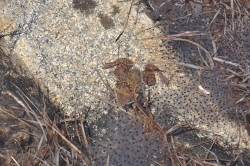Press Release, 18. June 2020
The disease pyramid: environment, pathogen, individual and microbiome
The body’s own bacteria and viruses influence diseases in amphibians
Researchers from the Leibniz-Institute of Freshwater Ecology and Inland Fisheries (IGB), the Université de Toulouse and the Helmholtz Centre for Environmental Research (UFZ) show how the microbial colonisation of the organism influences the interactions between living organisms, the environment and pathogens, using amphibians like frogs as examples. This is basic research for health prophylaxis.
Biotic and abiotic environmental factors have a strong influence on the dynamics of diseases in humans and animals. In their study, the researchers focus on an important component: the microbiome. The individual microbiome of a living being is a vital component of immunity. Especially on the skin and in the bowel, i.e. directly at the interface between the individual and pathogens, endogenous bacteria and viruses are highly active.
The international team presents the concept of a disease pyramid with the four cornerstones of environment, pathogen, host and microbiome. For the first time, the different functions of the microbiome are taken into account. The researchers illustrate this by using the amphibian disease chytridiomycosis caused by the fungal pathogen Batrachochochytrium dendrobatidis.
"The microbiome of living organisms is highly variable. It is only in recent years that researchers have succeeded in using genetic methods to determine the totality of microorganisms. We are now only gradually beginning to understand their role in health prophylaxis and how they interact, for example, with the environmental microbiome, pathogens and the host," explains IGB researcher Dr. Adeline Loyau, who led the study.
Diversity of microbiome and habitats strengthens resistance
The authors emphasise that more diverse microbiomes can make the host more resistant to pathogens because they are better able to keep potential pathogens at bay. The study also shows that individuals who inhabit complex and therefore species-rich habitats have a lower mortality rate. The team shows that the microbiome can act very specifically against pathogens: The symbiotic skin bacterium Janthinobacterium spp. forms an anti-fungal agent as a metabolic product and thus prevents infection with Batrachochytrium dendrobatidis.
Climate change modifies the microbiome of amphibians
It is assumed that the adaptability of the microbiome can in turn increase the organism’s adaptability to environmental influences. There are several examples of this in the animal kingdom. However, environmental changes such as climate change can also throw the microbiome out of balance: "A microbiome in equilibrium can protect against infection in changing environmental conditions," explains the study’s first author, Adriana P. Bernardo-Cravo from the Université de Toulouse and the UFZ. "However, it is also shown that environmental changes - especially temperature - have a significant impact on the composition of the microbiome, and thus on the resistance of amphibians to Batrachochytrium dendrobatidis. Climate change will significantly change the distribution of this fungal disease in amphibians," the ecologist predicts.
Axa-Professor Dirk Schmeller from the Université de Toulouse, further explains: "We have to be aware that climate change and biodiversity loss are stress factors for ecosystems, for humans, for animals and for the microbiome. Our research shows that if the different axes of the disease pyramid are destabilised, new infectious diseases can be expected, including for humans." The presented concept of the disease pyramid is therefore trend-setting for research on human-animal-plant-environment interactions and the resulting risks for biodiversity and humans.
Publication:
Bernardo-Cravo, A., Schmeller, D.S., Chatzinotas, A., Vredenburg, V.T., Loyau, A., 2020. Environmental Factors and Host Microbiomes Shape Host-Pathogen Dynamics. Trends in Parasitology 36, 29-36. https://doi.org/10.1016/j.pt.2020.04.010
Further information
Prof. Dr. Dirk Schmeller (Amphibian expert)
École Nationale Supérieure Agronomique de Toulouse
dirk.schmeller@toulouse-inp.fr
Dr. Adeline Loyau
Leibniz-Institute of Freshwater Ecology and Inland Fisheries (IGB)
loyau@igb-berlin.de
Adriana P. Bernardo-Cravo
UFZ-Department Environmental Microbiology
adriana-paula.bernardo-cravo@ufz.de
Prof. Dr. Antonis Chatzinotas
UFZ-Department Environmental Microbiology, Head of working group Microbial Interaction Ecology (Microbiome Expert)
antonis.chatzinotas@ufz.de
UFZ press office
Susanne Hufe
Phone: +49 341 6025-1630
presse@ufz.de
In the Helmholtz Centre for Environmental Research (UFZ), scientists conduct research into the causes and consequences of far-reaching environmental changes. Their areas of study cover water resources, ecosystems of the future, environmental technologies and biotechnologies, the effects of chemicals in the environment, modelling and social-scientific issues. The UFZ employs more than 1,100 staff at its sites in Leipzig, Halle and Magdeburg. It is funded by the Federal Government, Saxony and Saxony-Anhalt.
www.ufz.deThe Helmholtz Association contributes to solving major challenges facing society, science and the economy with top scientific achievements in six research fields: Energy; Earth and Environment; Health; Key Technologies; Matter; and Aeronautics, Space and Transport. With some 39,000 employees in 19 research centres, the Helmholtz Association is Germany’s largest scientific organisation.
www.helmholtz.de
